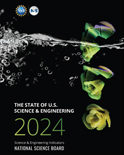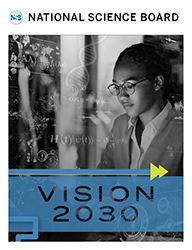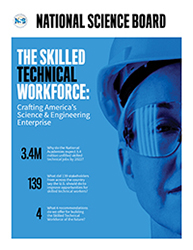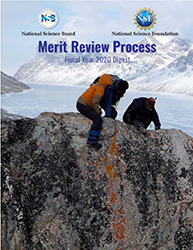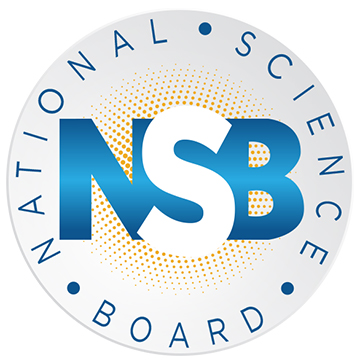
Business funding for university research grew faster than federal funding in 2021
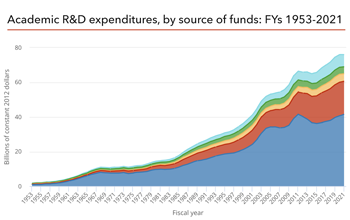
Academic R&D expenditures, by funding source (Credit and Larger Version)
October 5, 2023
A new report shows that between 2012 and 2021 academic research and development (R&D) funded by businesses grew faster than academic R&D funded by the federal government, although federal funding still makes up the largest overall share.
The National Science Board published the report, Academic Research and Development as part of the 2024 congressionally mandated Science and Engineering Indicators suite of products on the state of the U.S. science and engineering enterprise. The reports are prepared by the NSF’s National Center for Science and Engineering Statistics under the Board’s guidance. The report provides in-depth information on how universities are funded to support research and train future scientists and engineers.
“When we talk about academic research and development, we’re focused on funding basic research and talent development, both of which have roots in the National Science Foundation,” Steven Leath, past president of Iowa State and Auburn universities and member of the National Science Board, said. “This new report highlights an essential partnership between federal and industry spending on academic research. However, although it’s promising to see academic research funded by business increase, we want to make sure that federal dollars also continue to increase and support the next generation of scientists and engineers,” Leath said.
In addition to comparing the contributions of federal and business funding to academic research and development, the report also looks at the types of R&D performed at universities, where highly funded universities are located, how public institutions compare to private, how spending varies by discipline, and trends in the training of the future research workforce in academic institutions.
Highlights from the report:
- The federal government provided nearly 55% of all funds for academic R&D in 2021, down from 61% in 2012. Six agencies provided over 90% of that federal support – the Department of Health and Human Services (HHS), the Department of Defense (DOD), the National Science Foundation (NSF), the Department of Energy (DOE), the National Aeronautics and Space Administration (NASA), and the Department of Agriculture (USDA).
- Spending on biological, biomedical, and health science research and development is the primary driver of academic R&D. Funding is concentrated in academic institutions that have medical schools and postdoctoral appointments in biological, biomedical, and health science research and development.
- More U.S. trained women joined the science and engineering doctoral academic workforce than men. The number of women grew from about 78,700 to about 140,800 between 2003 and 2021 (increasing by 62,100), while the number of men grew from about 180,700 to about 206,400 (increasing by 25,700). In 2021, 41% of science and engineering doctorate holders employed in academia were women.
- Between 2006 and 2021, participation of Black, Hispanic, and American Indian or Alaska Native individuals in academic science and engineering education increased. In 2021, 10% percent of science and engineering doctorate holders employed in academia and 9% of full-time faculty were individuals who identified as Black or African American, Hispanic or Latino, and American Indian or Alaska Native—groups that are collectively underrepresented in science and engineering relative to their share of the population—compared with 8% and 7%, respectively, in 2006.
- Academic R&D spending is concentrated in a relatively small share of all U.S. higher education institutions. In 2021, the research performed at the 131 institutions with very high research activity accounted for nearly 75% of U.S. academic spending, out of 3,733 total institutions granting 4-year degrees. Those institutions also enrolled about 80% of the nation’s science and engineering doctoral students and employed over 80% of the nation’s science and engineering postdocs.
- In the last 30 years, science and engineering doctorate holders made an employment shift from the academic to the for-profit business sector. In 1993, nearly half of doctorate holders (45%) were employed by universities and 4-year colleges and 31% were employed by private, for-profit businesses. By 2021, these percentages shifted, with 39% in 4-year educational institutions and 37% in for-profit businesses.
Academic Research and Development is the first of 10 Science and Engineering Indicators reports that the NSB will publish over the coming months through spring of 2024.
About Science and Engineering Indicators
Science and Engineering Indicators is a congressionally mandated report on the state of the U.S. and international science and engineering (S&E) enterprise. Indicators provides high-quality quantitative information on the S&E enterprise in a series of reports and a data tool that provides state-level data.
About the NSB
The National Science Foundation Act of 1950 charged the NSB with two roles: to be the governing board of the NSF and an advisor to Congress and the President on policy matters related to STEM research and STEM education. Selected for their distinguished service and accomplishments in academia, government, and the private sector, the Board’s 24 presidentially appointed members are leaders in STEM research and education.
About the NCSES
NSF’s National Center for Science and Engineering Statistics (NCSES) is the nation's leading provider of statistical data on the U.S. science and engineering enterprise. As a principal federal statistical agency, NCSES serves as a clearinghouse for the collection, interpretation, analysis, and dissemination of objective science and engineering data.
Media Contact: Elizabeth Jeffers, National Science Board, (703) 292-7496, ejeffers@nsf.gov
Useful NSB Web Sites:
Home Page: http://www.nsf.gov/nsb
Media Contact: http://www.nsf.gov/staff/staff_bio.jsp?lan=nlymn&org=NSF
News: http://www.nsf.gov/nsb/news
Meetings: http://www.nsf.gov/nsb/meetings
Publications: http://www.nsf.gov/nsb/publications
Facebook: https://www.facebook.com/NationalScienceBoard
Twitter: Twitter: https://twitter.com/intent/user?screen_name=NSF_NSB
YouTube: https://www.youtube.com/channel/UCkrHRzuGSrPp2haQs0T_Pww
To view PDF documents, please download Adobe Acrobat Reader.
